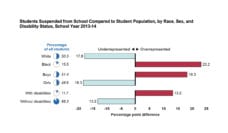Over the last 20 years, breakfasts and lunches served in schools have become significantly healthier. What used to be a fried chicken tender with a side of fries is now grilled chicken and a green salad. According to the School Nutrition and Meal Cost Study, a nationally representative survey conducted every 5 years, school breakfasts have become 41% healthier and school lunches 44% healthier since 2010. These changes are largely attributable to the Healthy, Hunger-Free Kids Act (HHFKA) — landmark legislation passed in 2010 which updated nutrition standards for school breakfast and lunch, established nutrition standards for snacks sold in schools, and strengthened requirements for local wellness policies.
Healthy Eating Research, a national program of the Robert Wood Johnson Foundation, supported new analyses of data from the School Nutrition and Meal Cost Study. Results from these studies are collected in a recent special issue of the journal Nutrients. The analyses examine the effects of the HHFKA on the nutritional quality of meals served, quality of students’ diets, and disparities in the school meal environment.
School meals are now one of the healthiest sources of foods for school-aged children. Results from a study by Bardin and colleagues found that the nutritional quality of school meals improved nationwide, and that there are no significant differences in the nutritional quality of school lunches across race/ethnicity and poverty subgroups. High poverty and majority Black and Hispanic schools had more healthful school environments than other school types, likely due to strong local wellness policies. Furthermore, a study by Gearan et al. suggests that school lunches are significantly healthier than meals brought from home, in both lower-income and higher-income subgroups and white and Black students.
These findings suggest that offering universal free meals could have lasting positive impacts on school-age children without having negative impacts on meal costs.
Given the important role school meals play in the overall diet quality and nutrition security of school-age children, policies that increase the availability and accessibility of school meals have started to receive significant attention. One such example is universal free meals, or Healthy School Meals for All, whereby all students—regardless of income—receive free school breakfast and lunch. Michael Long’s team evaluated the financial impacts of serving free meals to all students and found that universal free meals are associated with lower meal costs for schools and school districts. This suggests that schools serving universal free meals can provide healthy meals to more students without a financial disadvantage. A systematic review in the special issue found that universal free meals are associated with improved participation in school meal programs, diet quality, food security, and academic performance. These findings suggest that offering universal free meals could have lasting positive impacts on school-age children without having negative impacts on meal costs.
Despite the significant improvements in the nutrition standards for school meals, one major gap remains—added sugar. Fox and colleagues found that most schools exceeded the Dietary Guidelines for Americans recommended limit for added sugars (no more than 10% of calories from added sugars daily) at breakfast (92%) and lunch (69%). In both cases, the leading source of added sugars was flavored milk. There is an urgent need to establish an added sugar limit for school meals and restrict or limit flavored milk at school given the high added sugar consumption documented among school-age children.
Over 30 million children consume school lunches daily and 21.5 million are from low-income families. The findings from the School Nutrition and Meal Cost Study and analyses in the special issue affirm that the National School Meal Programs are a critical nutrition safety net for school-age children. They also emphasize the importance of policies for strengthening nutrition standards and expanding the availability of school meals.
Photo via Getty Images
















